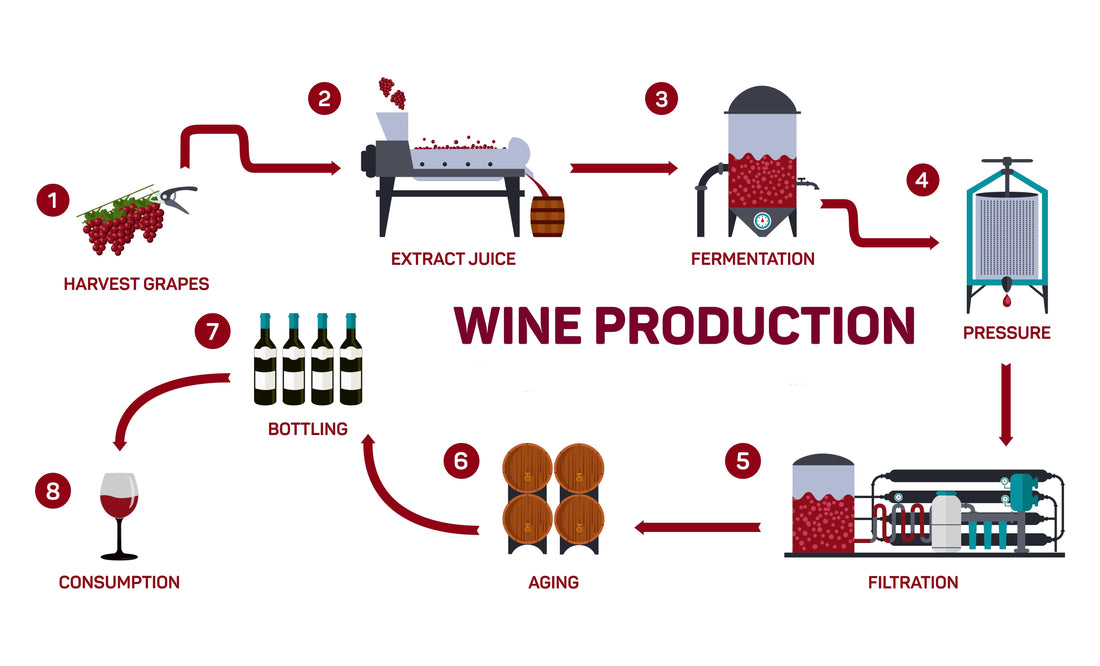
How Wine Is Made: Red, White, Rosé & Sparkling Explained
Ever wondered how wine is made? From the vineyard to the bottle, winemaking is a delicate process that combines science, craftsmanship, and timing. While the core steps remain consistent, the method varies depending on whether you're making red, white, rosé, sparkling, or dessert wines. Here's a comprehensive look at each stage—and how the process differs among different types of wine.
1. Harvesting the Grapes
The journey begins in the vineyard. Grapes are typically harvested between late summer and early fall, either by hand or machine. Timing is critical—grapes must be picked when sugar, acidity, and tannin levels are in balance.
Red wines: Grapes are harvested at full ripeness to ensure depth, color, and tannin.
White wines: Often picked slightly earlier to retain crisp acidity and lighter flavors.
Rosé wines: Timing varies based on the desired balance between fruit and freshness.
2. Extract Juice (Crushing)
After harvest, grapes are crushed and destemmed to break the skins and release juice, while removing stems that can contribute bitterness.
Red wines: Crushed grapes (juice, skins, seeds) go straight to fermentation tanks.
White wines: Skins are immediately separated to avoid color and tannin extraction.
Rosé wines: Grapes are left with skins briefly—usually just a few hours—for a pink hue.
3. Fermentation
This is where sugar turns into alcohol, powered by yeast. It’s the most crucial stage of winemaking, and it varies based on the type of wine.
Red wines: Fermented with skins for days or weeks to extract color and tannins, typically at warmer temperatures (75–85°F).
White wines: Fermented without skins at cooler temps (50–60°F) to preserve delicate aromas.
Rosé wines: Fermented like white wine—cooler, with skins removed early.
4. Pressing
Pressing separates the fermented liquid from grape solids.
White wines: Pressed before fermentation.
Red wines: Pressed after fermentation.
Rosé wines: Depending on method—either direct press or short maceration.
5. Filtration
The wine is filtered to remove particles like yeast cells, skins, and sediment. This step ensures clarity and shelf stability. Most wines undergo filtration before bottling, though natural wines may skip this step.
6. Aging
Wines are aged to develop flavor, either in stainless steel tanks, oak barrels, or bottles.
Red wines: Often oak-aged to soften tannins and add vanilla or spice notes.
White wines: Can be steel-aged for freshness or oak-aged for creaminess.
Rosé wines: Briefly aged in steel to preserve their fruit-forward style.
7. Bottling
The final step. Bottling is done under sterile conditions. Some wines retain a hint of natural carbon dioxide for freshness; others include sulfites to help preserve them during storage and transit.
8. Consuption
The final product is ready to be enjoyed! Whether you're sipping a bold red, a crisp white, or a refreshing rosé, every bottle reflects the choices made at every step above.
What About Sparkling and Dessert Wines?
Sparkling wines undergo a second fermentation to create bubbles, either in the bottle (traditional method) or in tanks (Charmat method), depending on the desired style.
Dessert wines may be made from late-harvest grapes or fortified with alcohol to retain sweetness. Examples include Port, Sauternes, and Ice wine.
Final Thoughts
Winemaking is more than just fermentation—it’s an intricate process shaped by tradition, timing, and technique. Whether you enjoy crisp whites, bold reds, or refreshing rosés, understanding how wine is produced makes each sip that much more meaningful.
If you’re curious to taste how different techniques shape flavor, explore our premium wine collection, featuring wines made in a variety of styles.
